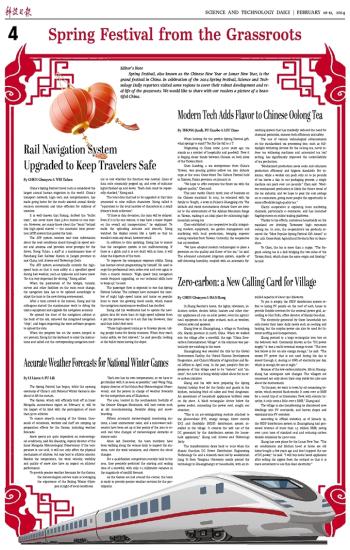
China's Spring Festival travel rush is considered the largest annual human migration in the world. China's transport network, high-tech and comprehensive, has made going home for the much-awaited annual family reunion convenient and time-efficient for millions of travelers.
It is well-known that Fuxing, dubbed the "bullet train", can cover more than 5,800 meters in one minute. However, not many know about the "brain" behind this high speed marvel — the automatic train protection (ATP) system that guides the train.
The ATP system receives real-time information about the road conditions ahead through its speed sensor and antenna and provides voice prompts for the driver, Xiong Yuhao, a staff at a maintenance base of Nanchang East Railway Station in Jiangxi province in east China, told Science and Technology Daily.
The ATP system automatically controls the high-speed train so that it runs safely at a specified speed during bad weather, such as typhoons and heavy snow."So it is very important for driving," Xiong added.
When the parameters of the bridges, tunnels, curves and other facilities on the train route change, the navigation data has to be updated accordingly to adapt the train to the new driving environment.
After a train arrived at the station, Xiong and his colleagues started the maintenance work to debug the train's equipment and upgrade the navigation accuracy.
He opened the door of the navigation cabinet at the back of the cab, removed the integrated navigation "chip", and began importing the reset software program to upload the data.
When the progress bar on the screen jumped to 100 percent, Xiong hit the keyboard to enter the instructions and called out the corresponding navigation module to test whether the function was normal. Lines of data code constantly popped up, and rows of indicator lights flashed up and down. "Each item must be repeatedly checked," Xiong said.
The total data that had to be upgraded at that time amounted to nine million characters. Xiong called it “equivalent to the total number of characters in a small library's book collection".
"If there is data deviation, the train will be delayed. Even if it is by one minute, it may have a major impact on the overall rail transportation," he explained. To make the uploading accurate and smooth, Xiong watched the display screen like a hawk so that he wouldn't miss any detail, however small
In addition to data updating, Xiong has to ensure that the navigation system is not malfunctioning. If there is a glitch and it is not dealt with in time, it will delay the departure of the train.
To improve his emergency response ability, Xiong has learned circuit programming by himself. He used to copy the professional term codes over and over again to form a muscle memory. "High-speed train navigation needs frequent upgrading, so our technical skills have to keep up," he said.
The passenger flow is expected to rise this Spring Festival holiday. The railways have increased the number of night high-speed trains and trains on popular lines to meet the growing travel needs, which means the navigation maintenance workload has doubled.
Xiong and his workmates had to update the navigation data for more than 60 high-speed railways from 6 pm the previous day to 8 am that day. However, they said they didn't feel tired.
"These high-speed trains go to faraway places, taking people home for family reunions. When they reach home safely, we feel relieved," he said proudly, looking at the bullet trains leaving the depot.







